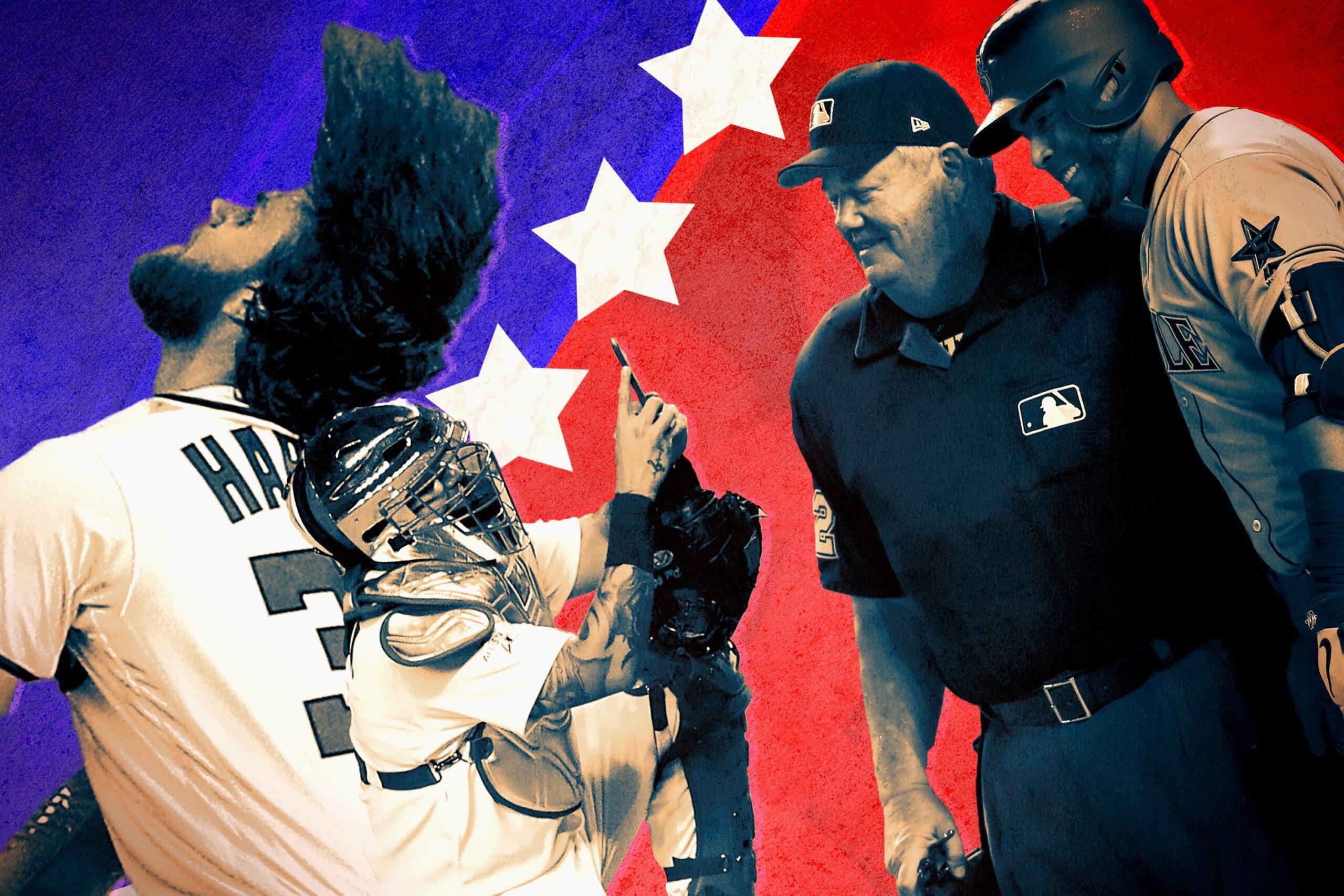
Tuesday’s MLB All-Star Game was a lackluster affair, but not because, for the first time since 2002’s infamous tie in Milwaukee, the game didn’t “count” by determining home-field advantage in the World Series. That wrinkle never attracted fans as former commissioner Bud Selig hoped, and its removal from the midsummer festivities is a net positive.
Rather, Tuesday’s 2–1 American League win was a slog because it turns out that when nearly every pitcher can flirt with triple digits with his fastball, it’s hard for even the best hitters in the world to keep up. The contest was representative of the sport’s long-term trend of increasing velocity and strikeout totals: The AL and NL pitching staffs combined for a 29.1 percent strikeout rate, which is just higher than Zack Greinke’s sixth-in-baseball mark this year.
For anarchical reasons and a desire for symmetry, I wanted a tie even before the game started. As the innings lengthened and the score remained 1–1 with no threat of changing, my excitement grew: A 2002 redux was a real possibility. Then Robinson Canó launched a 10th-inning homer, the NL couldn’t tie, and the festivities came to a close. Now we can all get on with speculating about the trade deadline and the second half of the season. But the All-Star Game wasn’t entirely forgettable; there were a handful of superlatives worth celebrating.
Closest Baseball Approximation to ‘The Purge’
With the game an official exhibition, players were free to experiment with their in-game presentation and bend the sport’s unwritten rules. For one night only, violators wouldn’t receive a beanball to the stomach.
During the regular season, a hitter might take offense to a fielder speaking with announcers during an at-bat. On Tuesday, George Springer and Bryce Harper both conducted interviews from the outfield. These conversations were neither enlightening nor especially insightful, but they were still a fun twist on baseball’s fixed broadcasting pattern. Springer’s bewilderment at third baseman José Ramírez standing so close to Giancarlo Stanton at the plate was worth a chuckle. (On a serious note, Springer, who has experienced a stutter his whole life and advocates on behalf of young people with a stutter, speaking extemporaneously on national television while fielding his position was a worthy and meaningful moment.)
The most prominent violation came in the sixth inning, when Nelson Cruz paused his at-bat to ask catcher Yadier Molina to take a picture of him with umpire Joe West, who officiated his 5,000th career game last month. Cruz then kept the cellphone in his back pocket as he continued to hit. As my colleague Rodger Sherman opined on Ringer Slack, “I think players should be suspended for beanballs much more strictly than they are EXCEPT I think you should be allowed to try to break a guy’s cellphone if he hits with it in his pocket.” Alas, pitcher Zack Greinke maintained his composure and induced a harmless flyout, exemplifying the one-night suspension of the sport’s most sacred rules.
Flashiest Uniform
When he wasn’t busy playing Ansel Adams, catcher Yadier Molina squatted behind the plate wearing a shiny-gold chest protector and matching mask. Much like Molina’s sixth-inning home run, the jokes flew: Did he look like C-3PO? A Roman legionnaire? Iron Man? As usual, Dodgers pitcher Brandon McCarthy offered the funniest take.
Best Defensive Plays
Runs were scarce as each team employed a revolving door of arms capable of firing upper-90s fastballs for an inning at a time. The game’s few highlights, then, came on the defensive end; no play was as singularly memorable as Torii Hunter’s 2002 home run robbery, but 2017’s All-Stars still exhibited a brand of effortless excellence with their gloves. Three plays stood out.
3. Don’t run on Mookie Betts.
Betts’s arm has been worth 15 runs above average since the start of last season, placing it among the MLB leaders. It victimized Nolan Arenado in the fourth inning, when Betts threw out the Rockies third baseman trying to tag up on a warning-track flyout.
2. José Altuve and Carlos Correa are a decent double-play duo (occurs 40 seconds into this video).
Correa’s toe-tap and strong throw off the wrong foot made for a pretty combo move. This play quelled an early NL rally and served as a fitting showcase for the best up-the-middle combo in the game.
1. Bryce Harper’s diving catch was the most boring part of this play.
Harper’s second-inning snag of a Salvador Pérez flare was more notable for his hair flip after his hat fell off mid-dive. His hair rose like a dolphin breaking through the crest of a wave. It was majestic. Harper’s mane alone should add another zero to the end of his free-agent contract after the 2018 season.
Most Ignored Statistic
Isolated power measures a hitter’s raw power by subtracting batting average from slugging percentage, thereby zeroing out singles. The game’s ISO stayed at triple zeroes for more than an hour, as the first eight hits of the night were all singles; over the full 10 innings, the two lineups combined for a .096 ISO, which is the a shade lower than Nori Aoki’s career mark. All-Star pitchers are good.
Deepest Position
Third basemen hit 5-for-8 with a walk, while players from all other positions combined for just 12 hits in 65 at-bats. José Ramírez slashed two singles and stole a base, Nolan Arenado collected two hits of his own, and Miguel Sanó blooped an RBI single to score the game’s first run. The group collected these numbers with All-Star-caliber bats from Kris Bryant, Anthony Rendon, and Travis Shaw all absent from the NL roster, squeezed out by a positional crunch. The hot corner is a hot-hitting position throughout the league.
Most Representative #That’sCub Moment
In 2016, the Cubs won 103 games and their first World Series since 1908; fittingly, they also filled the NL’s starting All-Star lineup with their entire starting infield. In 2017, they own a 43–45 record, they’ve allowed exactly as many runs as they have scored, and they sit 5.5 games back of Milwaukee in the NL Central. The Cubs sent only one player to the All-Star Game this year: Wade Davis, a closer who wasn’t on the team a year ago. He allowed a game-losing home run to the first batter he faced.

